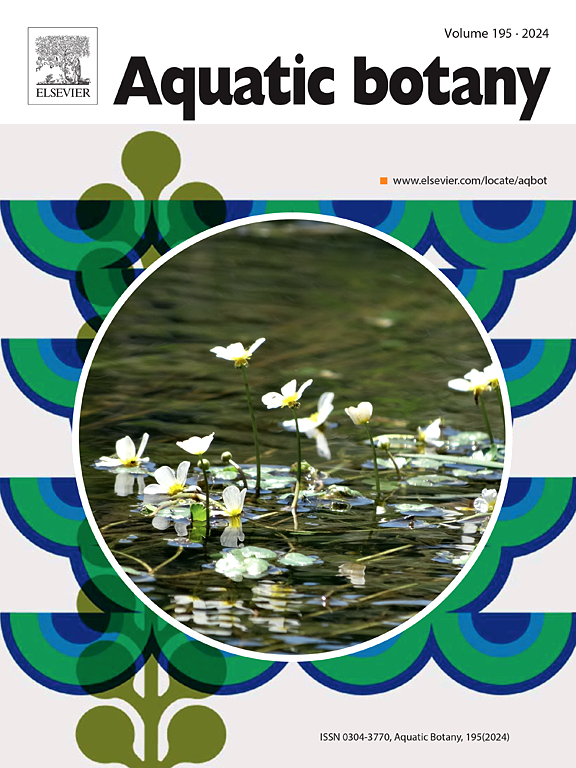Biological control alters competition between Pontederia crassipes Mart. (Pontederiaceae) and Salvinia minima Baker (Salviniales: Salviniaceae) in a eutrophic waterbody
IF 2.6
4区 生物学
Q2 MARINE & FRESHWATER BIOLOGY
引用次数: 0
Abstract
Pontederia crassipes remains a highly invasive weed globally, posing significant threats to aquatic ecosystems. Megamelus scutellaris, a biological control agent released in South Africa effectively manages this weed, even at eutrophic, and high-elevation cool sites. Biological control of P. crassipes at Hartbeespoort Dam, a hypertrophic system in South Africa plagued by nuisance macrophyte growth, was followed by the invasion of an aquatic fern, Salvinia minima. This study explains the population dynamics of P. crassipes and S. minima at Hartbeespoort Dam, as a function of M. scutellaris herbivory to P. crassipes. Competition and herbivory effects on both species were evaluated using an additive series analysis in mesocosms. Multiple regression analyses indicated that in the absence of herbivory on P. crassipes, its interspecific competition coefficient was 4 times greater than that of S. minima. The competitive vigour of S. minima more than doubled in the presence of herbivory on P. crassipes. Consequently, in the presence of the biological control agent, no statistically significant difference in interspecific competition for both species could be found. These results highlight how biological control of one species can alter the population dynamics between two competing species. While biological control of S. minima is under consideration in South Africa, in the absence of nutrient remediation, the system will remain vulnerable to further invasion.
生物控制改变了富营养化水体中 Pontederia crassipes Mart.(富营养化水体中的褐藻(Pontederia crassipes Mart.)和小叶沙文藻(Salvinia minima Baker)之间的竞争关系
鱼腥草(Pontederia crassipes)仍然是全球高度入侵的杂草,对水生生态系统构成严重威胁。在南非释放的生物控制剂 Megamelus scutellaris 能有效控制这种杂草,即使在富营养化和高海拔凉爽地区也是如此。南非哈特比斯波尔特水坝是一个深受大型藻类滋生困扰的富营养化系统,该水坝对 P. crassipes 进行生物防治后,水生蕨类植物 Salvinia minima 随之入侵。本研究解释了在哈特比斯福特水坝(Hartbeespoort Dam),黄颡鱼(M. scutellaris)对黄颡鱼(P. crassipes)的食草作用对黄颡鱼(P. crassipes)和小莎草(S. minima)种群动态的影响。采用中置模型中的加序分析法评估了竞争和草食对这两种物种的影响。多元回归分析表明,在 P. crassipes 没有食草动物的情况下,其种间竞争系数是 S. minima 的 4 倍。在 P. crassipes 上存在食草动物的情况下,S. minima 的竞争活力增加了一倍多。因此,在有生物防治剂存在的情况下,这两个物种的种间竞争在统计学上没有显著差异。这些结果突显了生物防治一个物种如何改变两个竞争物种之间的种群动态。虽然南非正在考虑对 S. minima 进行生物防治,但在缺乏营养补救措施的情况下,该系统仍很容易受到进一步入侵。
本文章由计算机程序翻译,如有差异,请以英文原文为准。
求助全文
约1分钟内获得全文
求助全文
来源期刊

Aquatic Botany
生物-海洋与淡水生物学
CiteScore
3.80
自引率
5.60%
发文量
70
审稿时长
6 months
期刊介绍:
Aquatic Botany offers a platform for papers relevant to a broad international readership on fundamental and applied aspects of marine and freshwater macroscopic plants in a context of ecology or environmental biology. This includes molecular, biochemical and physiological aspects of macroscopic aquatic plants as well as the classification, structure, function, dynamics and ecological interactions in plant-dominated aquatic communities and ecosystems. It is an outlet for papers dealing with research on the consequences of disturbance and stressors (e.g. environmental fluctuations and climate change, pollution, grazing and pathogens), use and management of aquatic plants (plant production and decomposition, commercial harvest, plant control) and the conservation of aquatic plant communities (breeding, transplantation and restoration). Specialized publications on certain rare taxa or papers on aquatic macroscopic plants from under-represented regions in the world can also find their place, subject to editor evaluation. Studies on fungi or microalgae will remain outside the scope of Aquatic Botany.
 求助内容:
求助内容: 应助结果提醒方式:
应助结果提醒方式:


